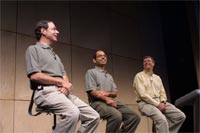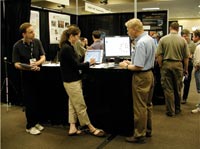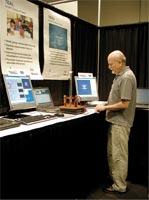On the Cutting Edge at Microsoft Research's Faculty Summit
Campus Technology heads West with Microsoft and SAC
magic time at microsoft
At Microsoft Research’s 6th Annual Faculty Summit (research.microsoft.com/collaboration/university)
in Redmond, WA, August 2, (left to right) Rick Rashid, senior VP of Microsoft
Research, Sailesh Chutani, director of Microsoft University Relations,
and Chairman Bill Gates Q&A’d with attendees. In his keynote,
Gates told the audience, “It’s hard to think of a domain that’s
going to change the world one 100th as much as advanced software will
in the decades ahead.” He added that, with their help, he hoped
“we can really show how magic software is, and how it can improve
the world.” The summit was created by Microsoft Research to engage
universities in cutting-edge research, with emphasis on the emerging computing
environment, transforming science by computing, and advancing the computer
science curriculum. It convened nearly 400 faculty from 135 higher education
institutions in 20 countries. |
 |
demos, demos,
everywhere


|
The Summit’s Demo Fest allowed close-up, hands-on interactions with
the technologies, including an ambitious group of iCampus projects from
MIT, a 3D sketching tool from the University
of Minnesota, and advanced classroom presentation software developed
by a University of Washington professor. Above, John
Belcher shows how MIT’s TEAL may be utilized in
Studio Physics courses; right, UW’s Richard Anderson demos Presenter. |
inside the summit sessions
Giving Summit attendees an inside glimpse of current research
initiatives and programs, several campus project teams and Microsoft Research
staff delved into areas as diverse as wireless sensor networks, Web services
architecture for online labs, grid computing, interactive photos and video,
and gender equity in IT. Right, Jesus del Alamo presents MIT’s iLabs
projects.
|

|
rocky moutain high ideals

|
Looking at the SAC conference setting from the rooftop tent in Snowmass
(left), it’s not hard to understand why, every summer for more than
30 years, higher ed IT leaders have met in Colorado to share ideas and
guide new director-level professionals.
|
Big Landscapes, Big Ideas
at the Seminars in Academic Computing (SAC)
SAC, now an Educause affiliate (www.educause.edu/conference/sac),
has traditionally focused on executive leadership development. This
year’s conference was aimed squarely at CIOs—both seasoned
execs and new directors—with strategic seminars for senior leaders,
and sessions offering new tools for those just coming into the IT leadership
role.
Each year, though the high-altitude venue offers a sense of retreat,
those pesky “back home” concerns bubble up in the conference
sessions. This year’s heavyweight topics: security, IT alignment
with institutional priorities, assessment, and the role of the university
in the information economy. No surprise was the fact that accountability
and delivering technology programs on tight budgets were also recurring
strategic planning themes. And in his opening address, Richard Detweiler
(Distinguished Fellow of the Council on Library and Information Resources)
maintained that technology development is easier than understanding
the related cultural and organizational consequences of that development.
He then offered a broad perspective on the leadership role of IT directors
and the impact of institutional technology planning.
Conference sessions covered myriad topics and urged directors to bridge
the gap between technology “concept” and communicating effectively
with constituencies in order to integrate technology components to serve
broader institutional goals. Says SAC Board Chair Joan Falkenberg-
Getman, “The idea is to think strategically about how the topics
will influence planning and direction.”
|